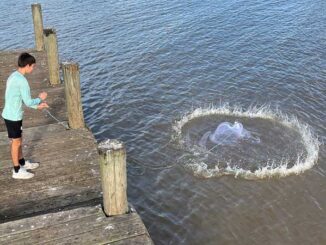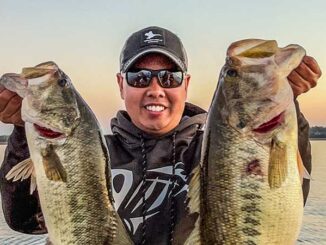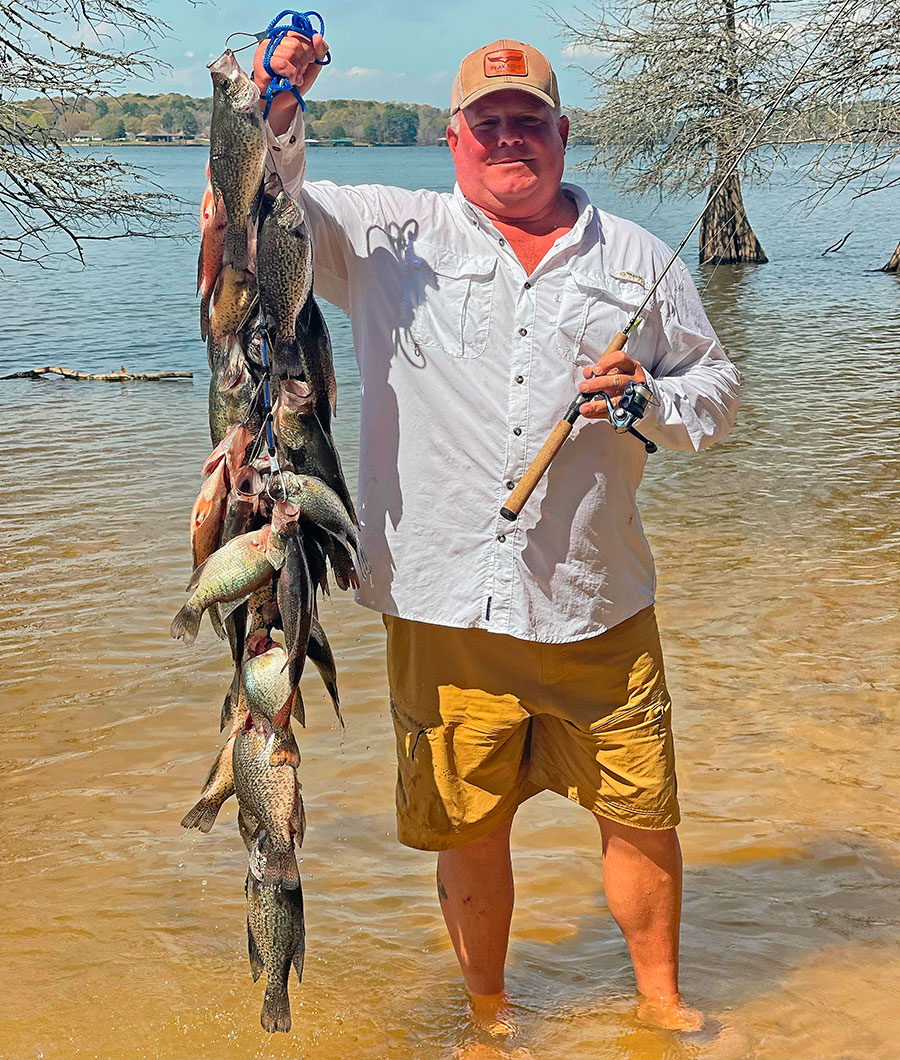
Alleman doesn’t let the full moon deter him from landing plenty of sac-a-lait
In the world of fishing, theories come a dime a dozen.
In the crappie fishing world, they’re a nickel a dozen. Take, for instance, the theory that you should never fish the morning after a full moon. The logic is quite simple: the light from the moon is bright enough to light up the water which allows the fish to feed throughout the night. Then when morning arrives the fish are full. Sounds logical right?
Not to Kevin Alleman of Negreet Bayou. Alleman grew up fishing for crappie in the Atchafalaya Basin and cut his teeth slinging slabs in the boat around Henderson Lake, Cow Island, and Bayou Benoit. During his crappie fishing career, he’s never let a full moon cancel his plans. If anything, he uses it to his advantage.
Alleman has been living on Toledo Bend since Hurricane Rita relocated him in 2005. Since then, he’s come to master the reservoir catching limits of fish on nearly every trip he makes. Although he grew up fishing sac-a-lait hotspots in Henderson, it wasn’t until he started fishing Toledo Bend that he was able to catch his biggest sac-a-lait, which weighed 3.19 pounds. The 56-year-old said if he was worried about the moon, he may not have caught that fish.
“That moon was mighty bright all night.” he joked. “I caught that fish in 32 feet of water in the Sabine River.” Alleman was using a live shiner when he caught the white crappie back in 2009.
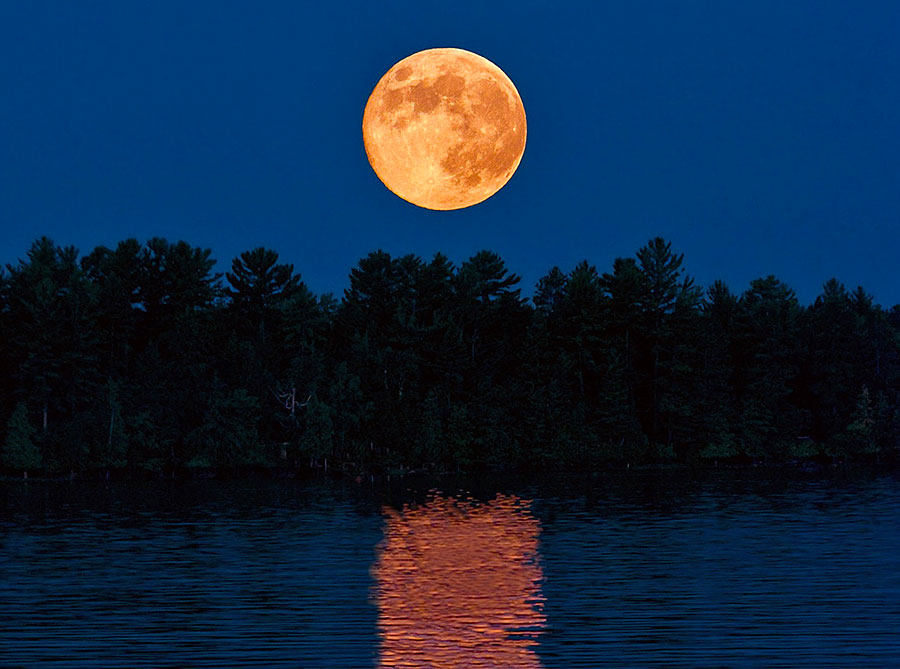
Full moon? Fish early!
Alleman fishes Toledo Bend for crappie. The once-truck-driver-turned-crappie guide has been operating professionally on the reservoir for 2 years and if there’s one thing that he’s learned from a full moon, it’s that there is an early bite that precedes the daylight.
“Let’s say I normally fish at daybreak,” he said. “If there’s a full moon overnight that bite is going to be about a half hour earlier I’ve found — so I’m getting out there a little earlier than I normally do.”
On days when the fish just aren’t biting early, Alleman is forced to wait on the fish until they get hungry again. This typically happens on a clear night when the moon is shining brightly. However, on nights when it’s cloudy it negates the full moon.
“You have to remember — just because it’s a full moon that doesn’t mean it’s going to be shining bright,” he said. “If it’s partly cloudy or overcast skies, that negates the effects of the full moon. So just because the moon is full it doesn’t necessarily mean that these fish are going to be eating overnight.”
Another factor that comes into play when fishing after a full moon is the depth at which you are fishing.
“If I’ve been catching my fish in 30 feet of water, then the moonlight is a non-factor because the light isn’t getting down to the bottom,” he said.
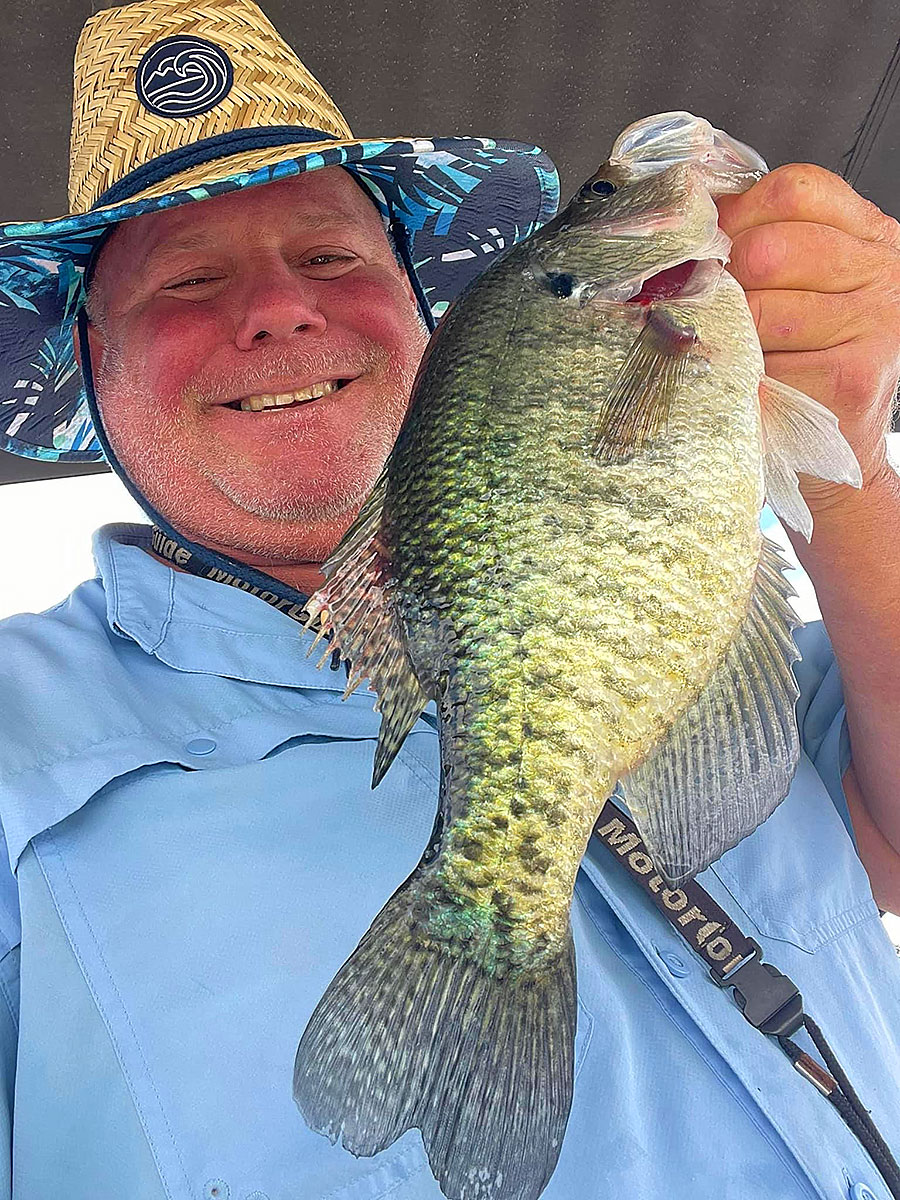
His setup
Alleman fishes from a 24-foot pontoon boat, which provides plenty of room for his clients.
“There’s no furniture up in the front so there’s nothing to disturb the expedition,” he said.
Since he utilizes a cast-and-retrieve method, he uses a spinning set-up over a jig pole.
“My preference is a 7-foot Shakespeare rod paired with a Shakespeare spinning reel,” he said.
He spools his reel with either 6 or 8-pound P-Line fluorocarbon line depending on the water clarity for that day.
Alleman’s go-to bait is a Bobby Garland Baby Shad soft plastic on a 1.32-ounce painted jighead.
“That pink and orange painted jighead is lights out over here on the Rez,” he said.
In May, his go-to body colors are Electric Chicken, Monkey Milk, Mayfly, and Bluegrass, all made by Bobby Garland. While artificial is his first choice, sometimes the crappie turn up their noses at plastic and he has to resort to live bait. In this case, Alleman threads a shiner onto a 3/0 gold Aberdeen hook with a 00 buck split shot clamped about 18 inches above the hook.
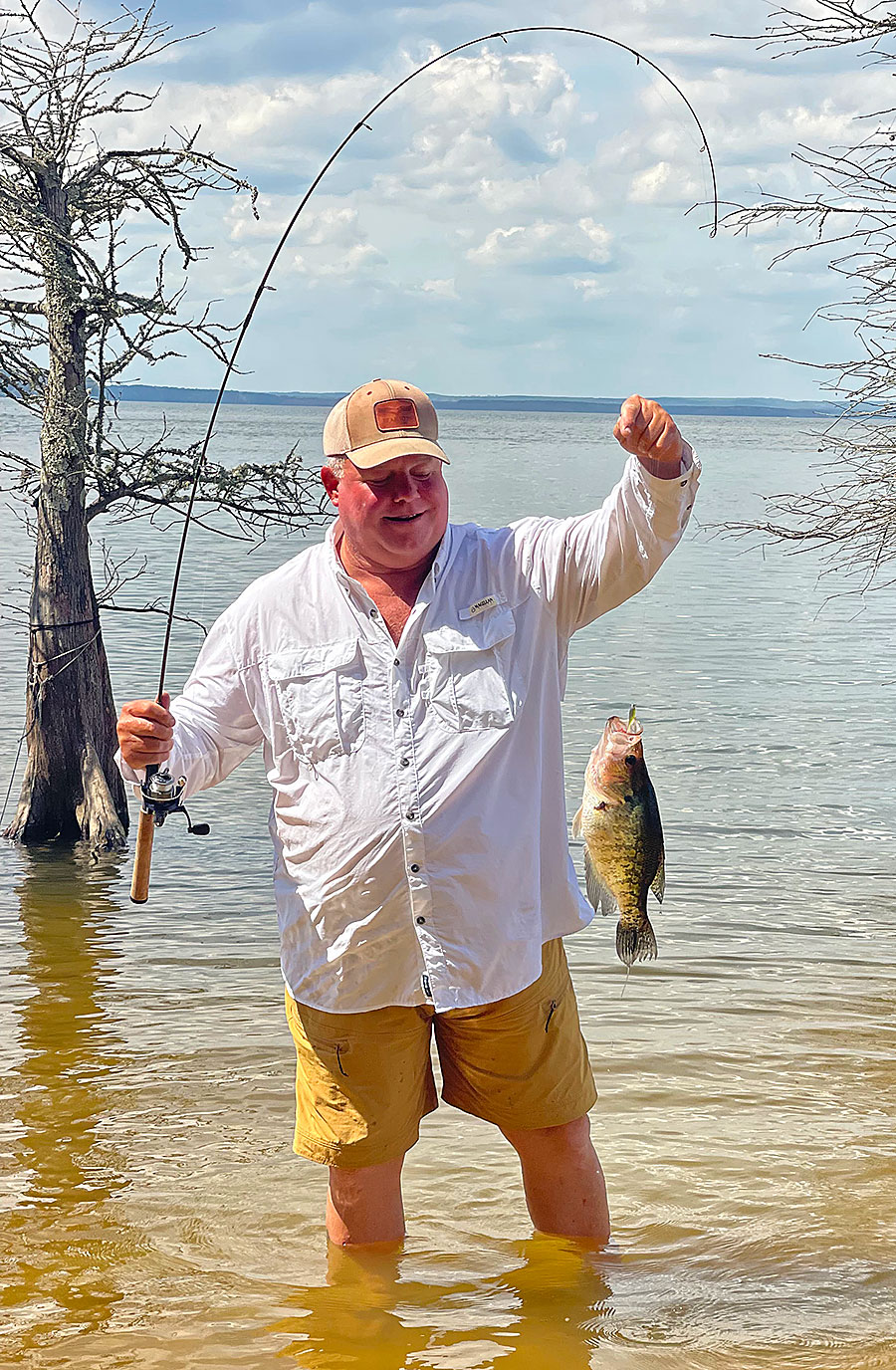
His technique
Catching sac-a-lait is a year-round process for Alleman. Over the years he has learned to locate areas that are favorable to crappie. After locating these spots he sinks structure to serve as spots on later trips.
“I put out fresh brush piles regularly on the reservoir,” he said. “First, I use the LiveScope to find new places that hold sac-a-lait. Once I find a new location, I go out into the woods and cut either sweet gum trees or switch cane.”
Alleman cuts the pieces about 15 feet tall and ties them to a cinder block that is used to anchor the bottom of the trees. On the opposite end of the branches, he ties an empty milk jug to the top of the tree. This forces the tree to stand up underwater presenting the structure vertically which is preferable over horizontal structure when fishing for crappie.
“This helps the trees stand up in the water columns,” he said. “These brush piles are where the food chain begins. This provides cover for the baitfish and shad.”
The brush piles attract two major species of baitfish at Toledo Bend — silverside minnows and thread fin shad.
The charter captain lays most of his brush piles in 25-30 feet of water in preparation for the summer when the lake heats up.
“Once the brush piles are set up, we roll up on them with a fishing crew,” he said. “Then all that’s left is to locate the fish on LiveScope and start casting to them.”
May lunar forecast
Crappie anglers can expect the Last Moon phase to happen on May 1. This phase is when the moon is half-lit at 50%. As it slowly dims it reaches its darkest stage on May 8 when it becomes a New Moon. The New Moon is one of Alleman’s favorite times to fish because the fish are the most easily patterned. As the moon waxes, it will reach its First Quarter phase halfway through the month on May 15 before transitioning to the Full Moon phase on May 23. This is a time that can be very exciting for crappie anglers as crappie feed best during the three days leading up to, and three days after the Full Moon. Alleman said these days are the absolute best days to fish, especially during the spawn when the moon phase plays a large role in how aggressively the fish feed.
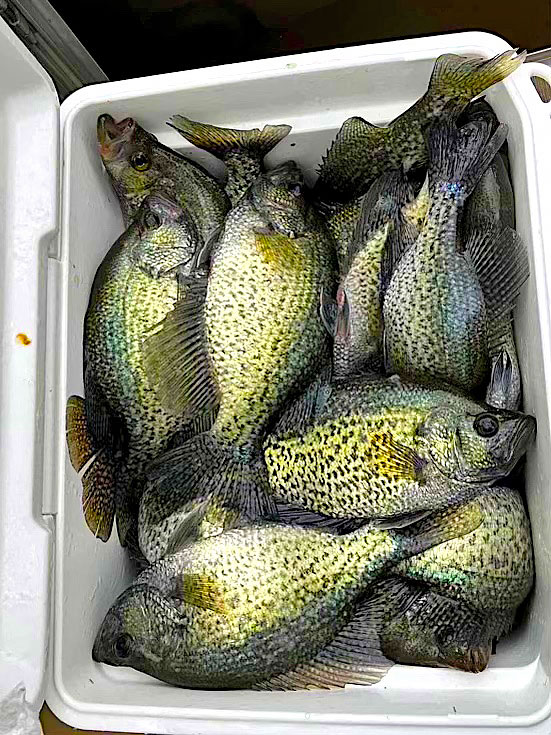
What’s working now
In May, Alleman recommends using shiners in deep water as the spawn is all but over and the fish are moving into deeper water.
“In May, I’ll be fishing over fresh brush piles in 20-25 feet of water,” he said. “Also, try moving around using your electronics to pick up single sac-a-lait off standing timber that’s in the area. Sometimes we find them on old lay-downs that have fallen over. After finding the fish, it’s all about putting that minnow on their nose which comes easy with Live Imaging Sonar. Watch the graph and drop that shiner down to the fish which are usually suspended over the brush pile. Position the bait in front of the fish and set the hook.”
As the page on the calendar turns from May to June, the water temperatures will be warming up in the reservoir. This is great news for folks who don’t want to bother with the moon because the fish will be in deep water over 40 feet all the time. While Alleman sets out his own brush piles, Toledo Bend offers 17 public artificial reefs that provide structure to fish for sac-a-lait. A popular sac-a-lait fishing spot is the Eagle Scout Reef near Pirate’s Cove Marina. Also, be aware that the crappie limit on the reservoir is 25, which can be a problem for Louisiana crappie fishermen who are used to the normal state limit of 50 fish.
